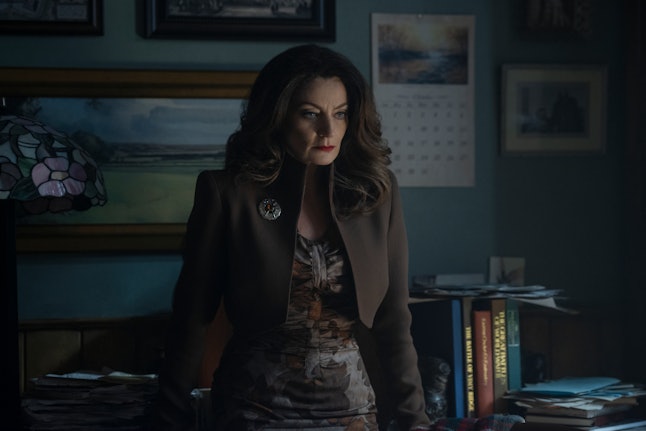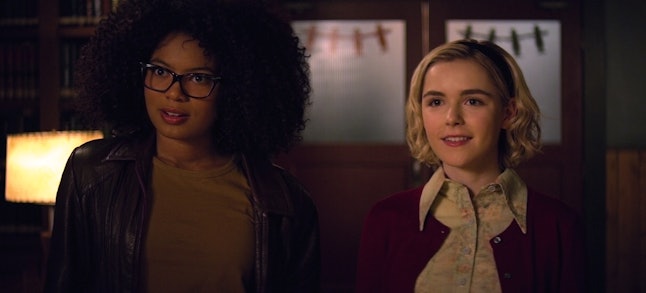Somewhere in Massachusetts sits the fictional town of Greendale, a place that’s perpetually in the throes of fall. It’s quaint with architecture similar to the brick faced houses and cobblestone paths of Salem, Massachusetts and it’s the setting for Chilling Adventures of Sabrina, Netflix’s adaptation of the classic Archie comic Sabrina The Teenage Witch.
For many, the name Sabrina Spellman brings up memories of Melissa Joan Hart and Salem, her sometimes witty talking cat. The television series Sabrina The Teenage Witch debuted in the mid ’90s, and was comedic enough to make magic palatable to a wide array of viewers. But Chilling Adventures is a much darker, more literal take on what it means to be a witch in a town based off Salem. And, it gave Sabrina fans of color hope to see a fresh take of the ’90s hit.
Netflix’s Chilling Adventures of Sabrina features more people of color in distinct, central roles that revolve around Sabrina Spellman. Cousin Ambrose (played by Chance Perdomo) adds comedic wit to the dark story, and one of Sabrina’s best friends, Roz (played by Jaz Sinclair), develops supernatural abilities as she slowly loses her eyesight to aggressive blindness. Then there’s the slightly villainous but immensely likable Prudence (played by Tati Gabrielle), who evokes the spirit of legendary Black icons like Josephine Baker and Eartha Kitt in both aesthetic and character.
Introducing three central characters of color was the perfect opportunity to apply a multi-cultural lens to magic and what it means to be a witch. Thanks to these additions, there was a palpable excitement by Sabrina fans of color to see how these characters’ cultures would be woven into the fabric of magic in Greendale.
But while the series may portray depth, it can — and should — go deeper. Netflix has a chance to diversify season two even more, and with the CAOS holiday special coming out Dec. 14, it’s a prime opportunity for the show’s creators to address the blindspots that appear in season one. (Bustle reached out to Netflix for comment, but did not hear back in time for publication.)
CAOS season one largely centers the concept of magic around whiteness, despite employing the names of witches of color like Tituba and Marie Laveau to the long list of witches Sabrina, her aunts, and villain Ms. Wardwell invoke during their conduction of an exorcism. The only main Black witch of the show is Prudence, but as Taylor Crumpton points out in her piece for Teen Vogue, “ the show positions Prudence as the angry Black woman who attacks the misunderstood, small, blonde, white girl.” Afro-Indigenous symbols make cursory, brief appearances in the Chilling Adventures of Sabrina, but without proper context, it seems as though they are placed there only to add a sense of exoticism to the coven’s magical practice.
CAOS producers can learn further into inclusivity by rethinking the show’s use of Voodoo. Ms. Wardwell, a personification of the biblical demon Lilith and the main villain of CAOS, has an affinity for using dolls as effigies to torture and maim her victims, a somewhat misguided nod to a myriad of global spiritual practices that use dolls in ritual. The Weird Sisters also use dolls to attempt to kill Harvey and his brother. While the practice of using dolls to inflict pain doesn’t derive specifically from Afro-Diasporic practice, it’s become closely and erroneously linked to Haitian Vodou and Louisiana Voodoo in the 20th century. In reality, these dolls aren’t a central component of Voodoo, nor are they used to harm others.
American culture has long posited Haitian Vodou as malevolent devil worship and used the concept of Vodou dolls to instill racialized fear in the American public. After the Haitian Revolution, the first successful slave rebellion in the Americas, the United States feared it would lose hold of its slave-based economy. The notion that Vodou, regardless of your proximity to it, could cause harm through these dolls was used to make Haitian Vodou seem all the more sinister, especially to white audiences. For decades, Hollywood has helped to widely popularize this incorrect connection by often painting the spiritual practice as being evil, and something to be feared. While CAOS never mentions Voodoo or gives context about using effigies to inflict pain, it still prominently features the dolls in multiple story arches. And, language used in recent reviews of the Netflix series describe and label the effigies as “Voodoo dolls.”
This constant misrepresentation of Voodoo and omission of cultural background isn’t specific to just CAOS. The show’s contemporaries like American Horror Story: Coven and the cancelled Salem also feature some distorted form of the Voodoo doll in plot lines. To avoid further perpetuating misrepresentation of Voodoo, it’s important to spend time elucidating on the dolls’ true historical significance.
In episode five, viewers are introduced to another Afro-Indigenous practice, as Sabrina faces off with the dream demon Batibat and uses a dreamcatcher to capture and imprison the entity. “Sometimes, the oldest, simplest magic works the best,” Sabrina tells Batibat. But dreamcatchers are relics originating from the Ojibwa-Chippewa spiritual practice. Sabrina’s description of dreamcatchers and the magic behind it positions it as a less complex, less nuanced form of magic in comparison to the Latinx-based spells the coven uses.
There is also more opportunity in season two to confront racial erasure and stereotypes head on, especially when it comes to the character Roz. When Sabrina, Roz, and Susie create a feminist organization called WICCA at Glendale High School, racism is a hot topic of conversation. It’s acknowledged that it exists. But we never actually see racism in the show, or any indication that race exists as a factor of identity. Roz’s Blackness has not yet inspired dialogue or attention in the series. CAOS attempts to flesh out Roz’s character by inserting a “curse” into her storyline. Her loss of eyesight is connected to her ability to have visions, or what her grandmother calls “the cunning”. Roz’s magical abilities are explained by a “curse” the Greendale Thirteen, white witches hung in 1692, put on Roz’s family line.
If we’re being historically accurate, Roz’s ancestors living in a 1692 Greendale were probably either slaves or were free but still with limited rights compared to other white residents. Massachusetts was the hub for the slave trade in New England in the 17th century after all. But the racism in colonial Massachusetts isn’t yet mentioned or navigated in Roz’s storyline. White women and their version of magic — not the wide array of African spiritual practices brought to the town by slaves and free Blacks — are the source of Roz’s supernatural powers. In season two and in the forthcoming holiday special, CAOS has a chance to spend more time developing Roz’s story line so that we can get the full sense for her character and not see her as a prop for Sabrina’s adventures.
The placement of Black and brown characters and Afro-Indigenous iconography is a major opportunity for upcoming seasons. Hopefully, we’ll see increased representation in December’s holiday-themed episode, as well as season two. And hopefully, the show will use this opportunity to add more depth to the characters of color instead of leaving them as glimmering mirages. If Netflix truly wants to tell a story about magic, the show must seek to broaden its scope to accurately portray ancestral traditions that have been around for thousands of years.
Source: Read Full Article

